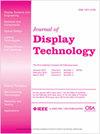单元内自电容式移动触摸系统及显示驱动IC中的嵌入式读出电路
Q Engineering
引用次数: 16
摘要
为了降低成本、提高显示性能和卓越的触摸性能,开发了一种移动显示系统,该系统包括自电容型单元内触摸屏面板和嵌入读出电路的显示驱动器IC。触摸电极是用LCD显示器的分段公共电极来实现的。单元内触摸板的显示系统为5.7英寸a-Si HD(720×1280),触摸电极数量为576个(18×32),传感器间距约为4mm。与仅显示系统相比,由于采用了单元内技术,因此所提出的系统不会出现显示性能下降。尽管在面板中使用了自电容传感方法,但通过使用全点传感方案,可以实现无限制的多点触摸;该系统显示出小于0.2mm的触摸精度,并且在没有任何数字滤波器的情况下在整个面板中测量到信噪比大于48dB。为了提高触摸性能,我们提出了与显示操作密切相关的降噪技术,如基线补偿、添加德尔塔的相关双采样以及使用高压电荷补偿器。包括微控制器单元(MCU)在内的功耗小于30mW。本文章由计算机程序翻译,如有差异,请以英文原文为准。
In-Cell Self-Capacitive-Type Mobile Touch System and Embedded Readout Circuit in Display Driver IC
A mobile display system, which includes a self- capacitive type in-cell touch screen panel and a display driver IC, in which the readout circuit is embedded, is developed for reduced cost, improved display performance, and superior touch performance. A touch electrode is implemented with a segmented common electrode of an LCD display. The display system of the in-cell touch panel is 5.7-in a-Si HD (720 × 1280), the number of touch electrodes is 576 (18 × 32), and the sensor pitch is approximately 4 mm. Compared to the display-only system, display performance degradation does not occur in the proposed system since in-cell technology is adopted. Despite using a self-capacitance sensing method in the panel, unlimited multitouch is available by using an all-point sensing scheme; this system shows a touch accuracy of less than 0.2 mm and signal-to-noise ratio is measured to be more than 48 dB in the entire panel without any digital filter. To enhance the touch performance, we proposed noise reduction techniques that are strongly related to the display operation, such as base line compensation, delta adding correlated double sampling, and the use of a high-voltage charge compensator. The power consumption including micro controller unit (MCU) is less than 30 mW.
求助全文
通过发布文献求助,成功后即可免费获取论文全文。
去求助
来源期刊

Journal of Display Technology
工程技术-工程:电子与电气
CiteScore
1.50
自引率
0.00%
发文量
0
审稿时长
2.8 months
期刊介绍:
This publication covers the theory, material, design, fabrication, manufacturing and application of information displays and aspects of display technology that emphasize the progress in device engineering, design and simulation, materials, electronics, physics, and reliability aspects of displays and the application of displays. The Journal is sponsored by EDS, seven other IEEE societies (BT, CES, CPMT, IA, IM, PHO and SSC) and the Optical Society of America (OSA).
 求助内容:
求助内容: 应助结果提醒方式:
应助结果提醒方式:


